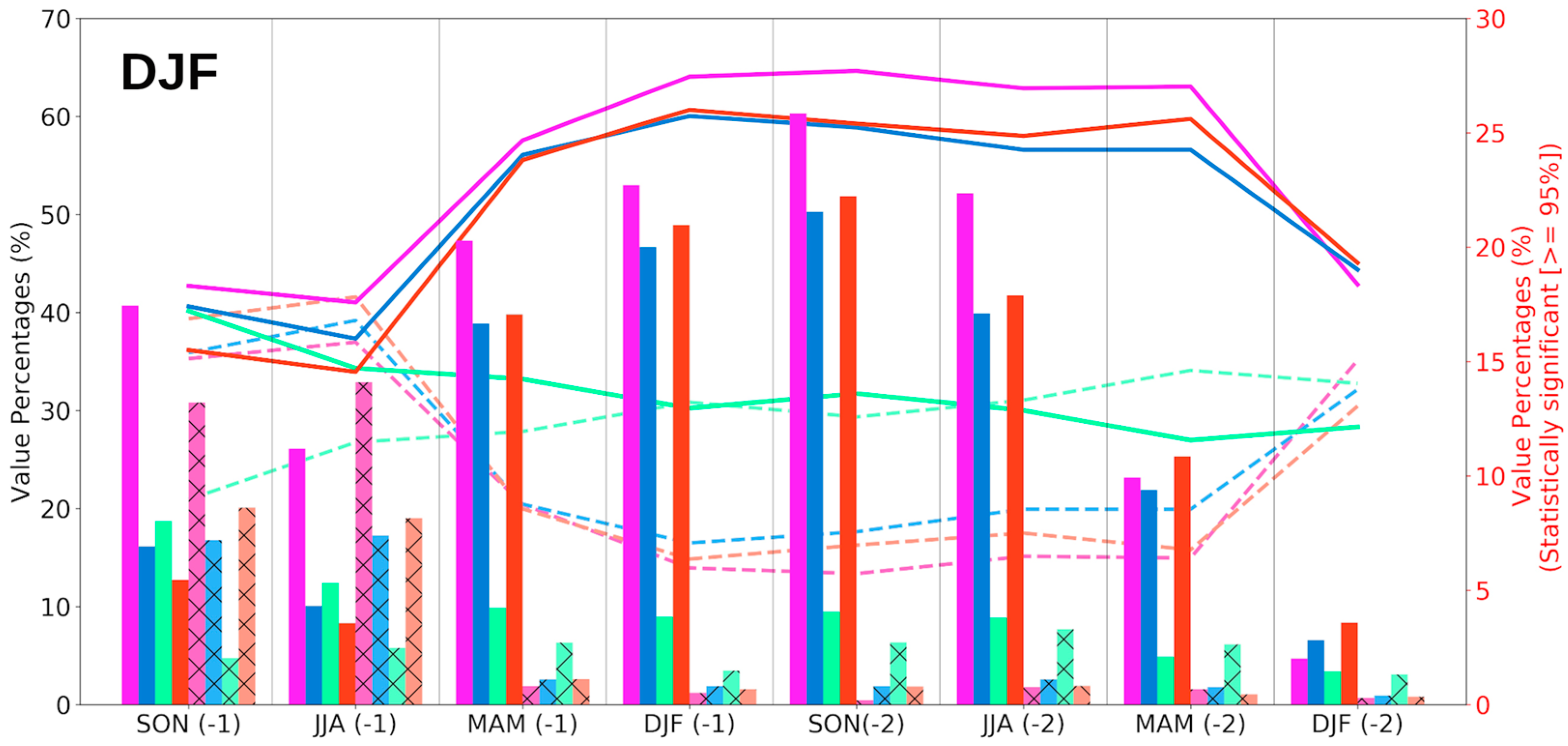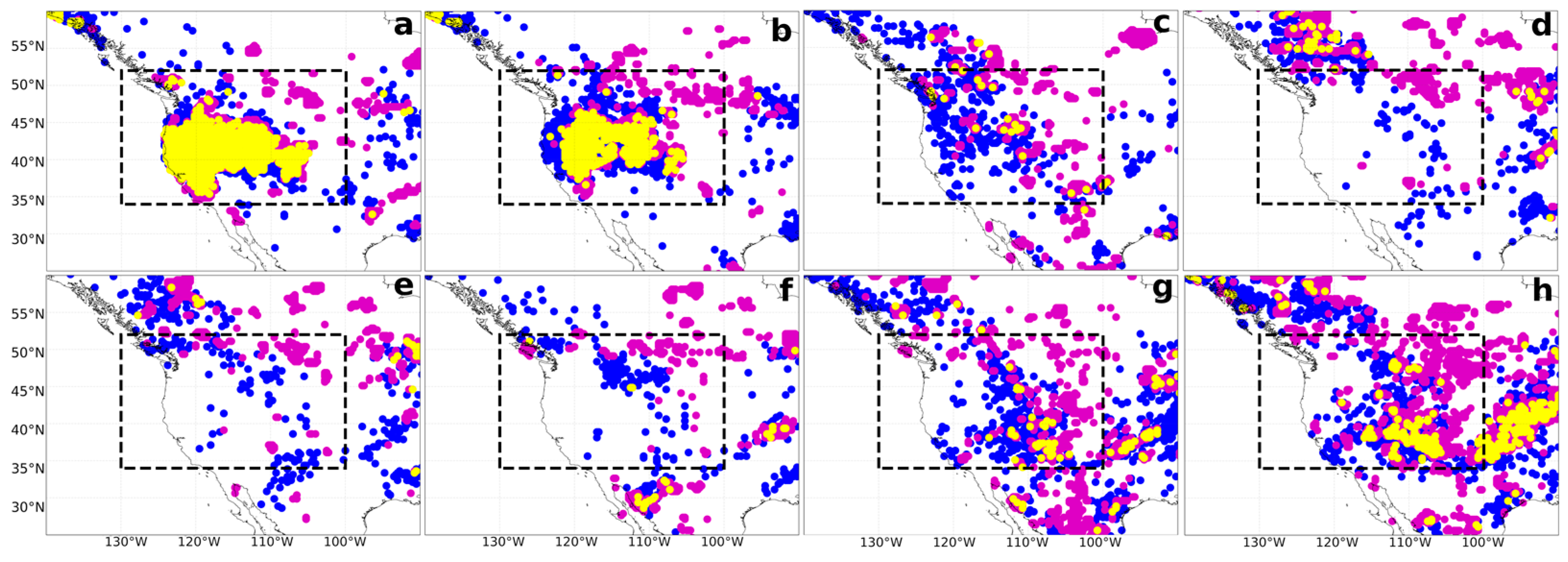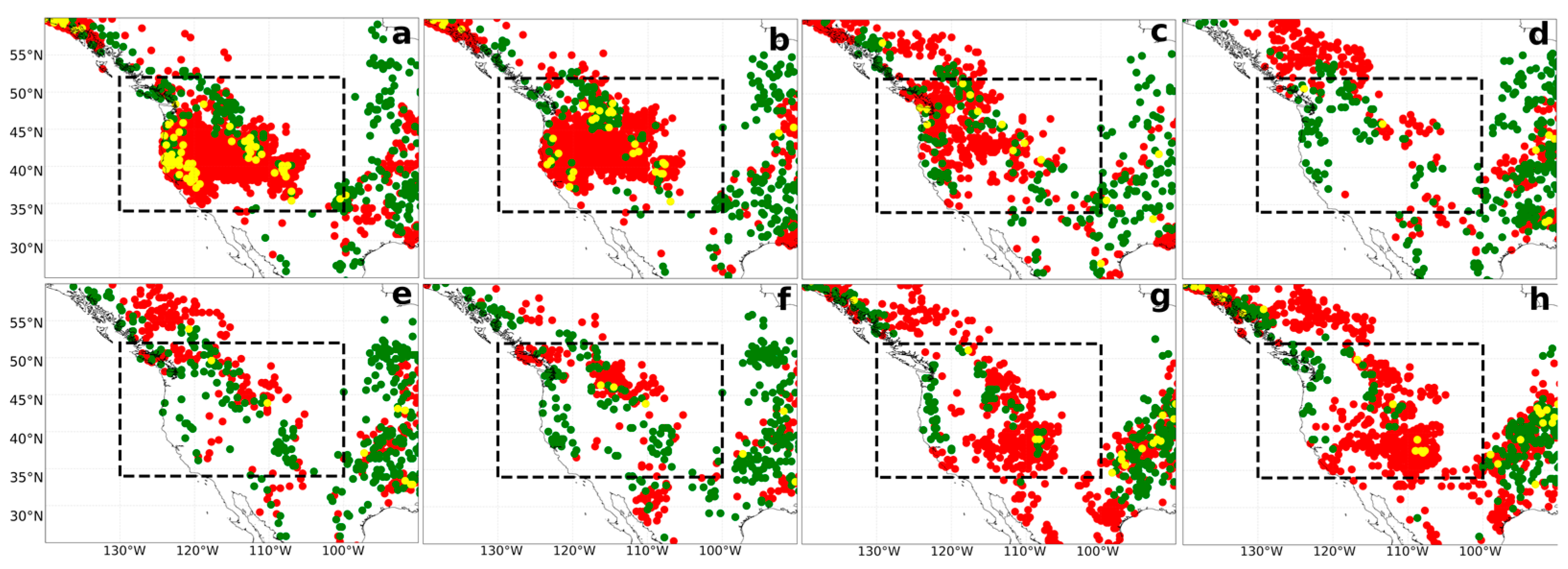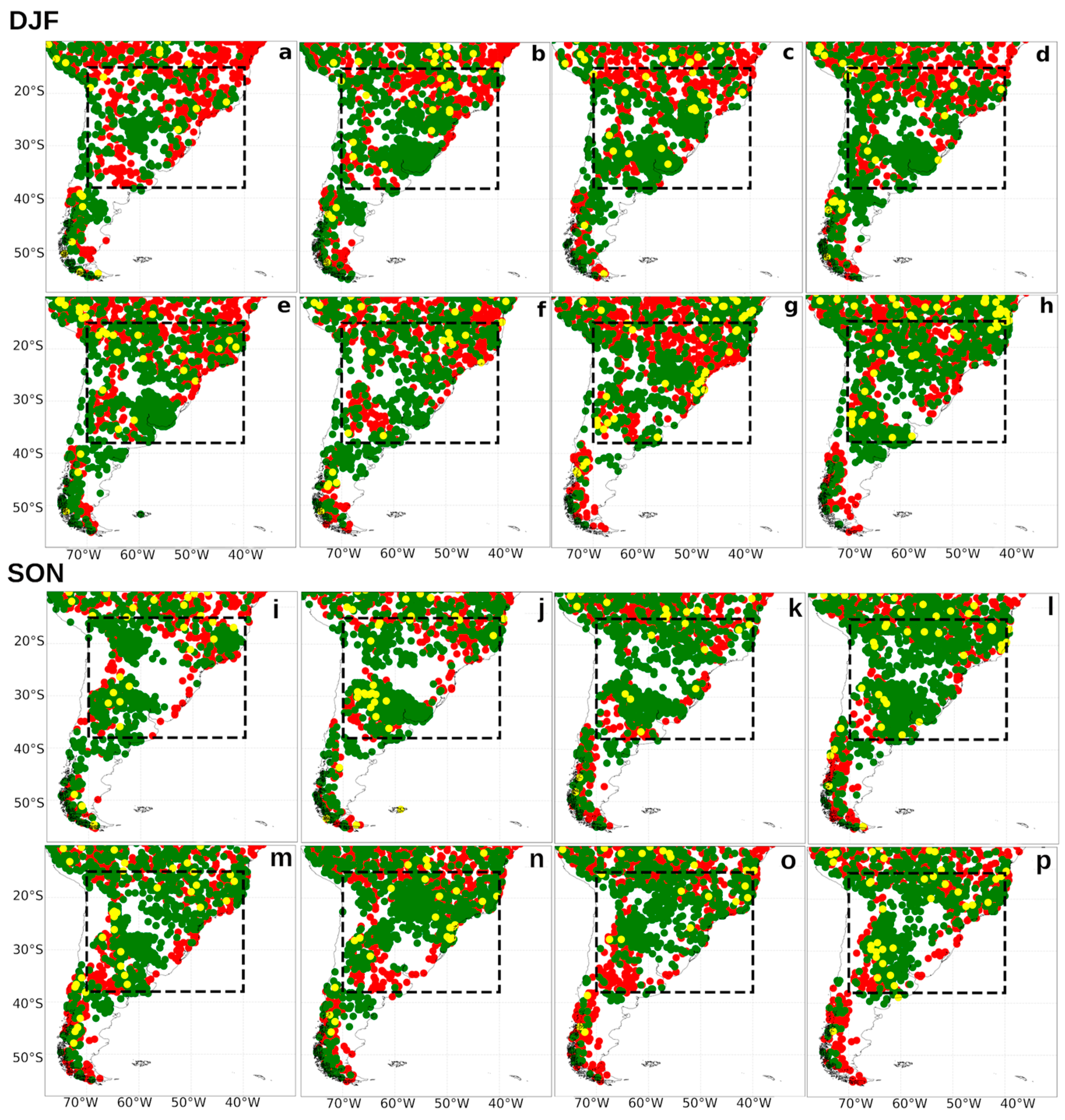Space-Time Causality Analysis of Regional Impacts of ENSO on Terrestrial and Oceanic Precipitation
Abstract
1. Introduction
Study Regions
2. Data and Methods
2.1. Data Used
2.2. Granger Causality Method
VAR Formulation
2.3. Methodology
3. Results and Discussion
3.1. Correlation and Granger Causality for WNA Region
3.2. Correlation and Granger Causality for ESA Region
4. Conclusions
Supplementary Materials
Author Contributions
Funding
Institutional Review Board Statement
Informed Consent Statement
Data Availability Statement
Acknowledgments
Conflicts of Interest
References
- Gimeno, L.; Nieto, R.; Sorí, R. The growing importance of oceanic moisture sources for continental precipitation. NPJ Clim. Atmos. Sci. 2020, 3, 27. [Google Scholar] [CrossRef]
- Manabe, S.; Wetherald, R.T. On the distribution of climate change resulting from an increase in CO2 content of the atmosphere. J. Atmos. Sci. 1980, 37, 99–118. [Google Scholar] [CrossRef]
- Allen, M.; Ingram, W. Constraints on future changes in climate and the hydrologic cycle. Nature 2002, 419, 228–232. [Google Scholar] [CrossRef]
- Held, I.M.; Soden, B.J. Robust responses of the hydrological cycle to global warming. J. Clim. 2006, 19, 5686–5699. [Google Scholar] [CrossRef]
- O’Gorman, P.A. Contrasting responses of mean and extreme snowfall to climate change. Nature 2014, 512, 416–418. [Google Scholar] [CrossRef]
- Huang, J.; Yu, H.; Guan, X.; Wang, G.; Guo, R. Accelerated dryland expansion under climate change. Nat. Clim. Chang. 2016, 6, 166–171. [Google Scholar] [CrossRef]
- Findell, K.L.; Keys, P.W.; Van Der Ent, R.J.; Lintner, B.R.; Berg, A.; Krasting, J.P. Rising temperatures increase importance of oceanic evaporation as a source for continental precipitation. J. Clim. 2016, 32, 7713–7726. [Google Scholar] [CrossRef]
- Sorí, R.; Gimeno-Sotelo, L.; Nieto, R.; Liberato, M.L.R.; Stojanovic, M.; Pérez-Alarcón, A.; Fernández-Alvarez, J.C.; Gimeno, L. Oceanic and terrestrial origin of precipitation over 50 major world river basins: Implications for the occurrence of drought. Sci. Total Environ. 2023, 859, 160288. [Google Scholar] [CrossRef]
- McGraw, M.C.; Barnes, E.A. Memory matters: A case for Granger causality in climate variability studies. J. Clim. 2018, 31, 3289–3300. [Google Scholar] [CrossRef]
- Martens, B.; Waegeman, W.; Dorigo, W.A.; Verhoest, N.E.; Miralles, D.G. Terrestrial evaporation response to modes of climate variability. NPJ Clim. Atmos. Sci. 2018, 1, 43. [Google Scholar] [CrossRef]
- Song, H.; Tian, J.; Huang, J.; Guo, P.; Zhang, Z.; Wang, J. Hybrid causality analysis of enso’s global impacts on climate variables based on data-driven analytics and climate model simulation. Front. Earth Sci. 2019, 7, 233. [Google Scholar] [CrossRef]
- Le, T.; Bae, D.H. Response of global evaporation to major climate modes in historical and future Coupled Model Intercomparison Project Phase 5 simulations. Earth Syst. Sci. Data 2020, 24, 1131–1143. [Google Scholar] [CrossRef]
- Le, T.; Bae, D.H. Causal influences of El Niño–Southern Oscillation on global dust activities. Atmos. Chem. Phys. 2022, 22, 5253–5263. [Google Scholar] [CrossRef]
- Correlation and Causation. Available online: https://www.abs.gov.au/statistics/understanding-statistics/statistical-terms-and-concepts/correlation-and-causation (accessed on 20 February 2023).
- Gimeno, L.; Vázquez, M.; Eiras-Barca, J.; Sorí, R.; Stojanovic, M.; Algarra, I.; Nieto, R.; Ramos, A.M.; Durán-Quesada, A.M.; Dominguez, F. Recent progress on the sources of continental precipitation as revealed by moisture transport analysis. Earth Sci. Rev. 2020, 201, 103070. [Google Scholar] [CrossRef]
- Algarra, I.; Nieto, R.; Ramos, A.M.; Eiras-Barca, J.; Trigo, R.M.; Gimeno, L. Significant increase of global anomalous moisture uptake feeding landfalling Atmospheric Rivers. Nat. Commun. 2020, 11, 5082. [Google Scholar] [CrossRef] [PubMed]
- Ropelewski, C.F.; Halpert, M.S. North American precipitation and temperature patterns associated with the El Niño/Southern Oscillation (ENSO). Mon. Weather Rev. 1986, 114, 2352–2362. [Google Scholar] [CrossRef]
- Yu, J.-Y.; Zou, Y. The enhanced drying effect of Central-Pacific El Niño on US winter. Environ. Res. Lett. 2013, 8, 014019. [Google Scholar] [CrossRef]
- Deser, C.; Simpson, I.R.; Phillips, A.S.; Mckinnon, K.A. How well do we know ENSO’s climate impacts over North America, and how do we evaluate models accordingly? J. Clim. 2018, 31, 4991–5014. [Google Scholar] [CrossRef]
- Payne, A.E.; Magnusdottir, G. Dynamics of landfalling atmospheric rivers over the North Pacific in 30 years of MERRA reanalysis. J. Clim. 2014, 27, 7133–7150. [Google Scholar] [CrossRef]
- Xiong, Y.; Ren, X. Influences of atmospheric rivers on North Pacific winter precipitation: Climatology and dependence on ENSO condition. J. Clim. 2021, 34, 277–292. [Google Scholar] [CrossRef]
- International Research Institute for Climate and Society. El Nino and Rainfall Map. Available online: https://iridl.ldeo.columbia.edu/maproom/IFRC/FIC/ElNinoandRainfall.png (accessed on 22 December 2022).
- Glantz, M.H.; Naranjo, L.; Baudoin, M.A.; Ramírez, I.J. What does it mean to be El Niño Ready? Atmosphere 2018, 9, 94. [Google Scholar] [CrossRef]
- Thomalla, F.; Boyland, M. Enhancing Resilience to Extreme Climate Events: Lessons from the 2015–2016 El Niño Event in Asia and the Pacific. 2017. Available online: https://policycommons.net/artifacts/1359439/enhancing-resilience-to-extreme-climate-events/1972676/ (accessed on 22 December 2022).
- do Nascimento, M.G.; Herdies, D.L.; Oliveira de Souza, D. The South American water balance: The influence of low-level jets. J. Clim. 2016, 29, 1429–1449. [Google Scholar] [CrossRef]
- Montini, T.L.; Jones, C.; Carvalho, L.M.V. The South American low-level jet: A new climatology, variability, and changes. J. Geophys. Res. Atmos. 2019, 124, 1200–1218. [Google Scholar] [CrossRef]
- Ferreira, R.N.; Rickenbach, T.M.; Herdies, D.L.; Carvalho, L.M. Variability of South American convective cloud systems andtropospheric circulation during January–March 1998 and 1999. Mon. Weather Rev. 2003, 131, 961–973. [Google Scholar] [CrossRef]
- Marengo, J.A.; Soares, W.R.; Saulo, C.; Nicolini, M. Climatology of the low-level jet east of the Andes as derived from the NCEP-NCAR reanalyses: Characteristics and temporal variability. J. Clim. 2004, 17, 2261–2280. [Google Scholar] [CrossRef]
- Nieto, R.; Gimeno, L. Addendum: A database of optimal integration times for Lagrangian studies of atmospheric moisture sources and sinks. Sci. Data 2021, 8, 130. [Google Scholar] [CrossRef]
- Nieto, R.; Gimeno, L. A database of optimal integration times for Lagrangian studies of atmospheric moisture sources and sinks. Sci. Data. 2019, 6, 59. [Google Scholar] [CrossRef]
- Stohl, A.; James, P. A Lagrangian analysis of the atmospheric branch of the global water cycle. Part I: Method description, validation, and demonstration for the August 2002 flooding in central Europe. J. Hydrometeorol. 2004, 5, 656–678. [Google Scholar] [CrossRef]
- Stohl, A.; Forster, C.; Frank, A.; Seibert, P.; Wotawa, G. The Lagrangian particle dispersion model FLEXPART version 6.2. Atmos. Chem. Phys. 2005, 5, 2461–2474. [Google Scholar] [CrossRef]
- Beck, H.E.; Wood, E.F.; Pan, M.; Fisher, C.K.; Miralles, D.M.; van Dijk, A.I.; McVicar, T.R.; Adler, R.F. MSWEP V2 global 3-hourly 0.1 precipitation: Methodology and quantitative assessment. Bull. Am. Meteorol. Soc. 2019, 100, 473–500. [Google Scholar]
- Smith, C.A.; Sardeshmukh, P. The Effect of ENSO on the Intraseasonal Variance of Surface Temperature in Winter. Int. J. Clim. 2000, 20, 1543–1557. [Google Scholar] [CrossRef]
- Granger, C.W.J. Essays in Econometrics: The Collected Papers of Clive W.J. Granger. Cambridge University Press: Cambridge, UK, 2001. [Google Scholar]
- Stats Models Statistics in Python. Available online: https://www.statsmodels.org/v0.10.2/ (accessed on 22 December 2022).
- Sorí, R.; Nieto, R.; Liberato, M.L.; Gimeno, L. Oceanic versus terrestrial origin of El Niño Southern Oscillation–associated continental precipitation anomalies. Ann. N. Y. Acad. Sci. 2021, 1504, 202–214. [Google Scholar] [CrossRef] [PubMed]







| Seasons (1983–2018) | Lag 1 | Lag 2 | Lag 3 | Lag 4 | Lag 5 | Lag 6 | Lag 7 | Lag 8 |
|---|---|---|---|---|---|---|---|---|
| DJF | SON (1982–2017) | JJA (1982–2017) | MAM (1982–2017) | DJF (1982–2017) | SON (1981–2016) | JJA (1981–2016) | MAM (1981–2016) | DJF (1981–2016) |
| SON | JJA (1983–2018) | MAM (1983–2018) | DJF (1983–2018) | SON (1982–2017) | JJA (1982–2017) | MAM (1982–2017) | DJF (1982–2017) | SON (1981–2016) |
Disclaimer/Publisher’s Note: The statements, opinions and data contained in all publications are solely those of the individual author(s) and contributor(s) and not of MDPI and/or the editor(s). MDPI and/or the editor(s) disclaim responsibility for any injury to people or property resulting from any ideas, methods, instructions or products referred to in the content. |
© 2023 by the authors. Licensee MDPI, Basel, Switzerland. This article is an open access article distributed under the terms and conditions of the Creative Commons Attribution (CC BY) license (https://creativecommons.org/licenses/by/4.0/).
Share and Cite
Alvarez-Socorro, G.; Fernández-Alvarez, J.C.; Gimeno, L. Space-Time Causality Analysis of Regional Impacts of ENSO on Terrestrial and Oceanic Precipitation. Atmosphere 2023, 14, 841. https://doi.org/10.3390/atmos14050841
Alvarez-Socorro G, Fernández-Alvarez JC, Gimeno L. Space-Time Causality Analysis of Regional Impacts of ENSO on Terrestrial and Oceanic Precipitation. Atmosphere. 2023; 14(5):841. https://doi.org/10.3390/atmos14050841
Chicago/Turabian StyleAlvarez-Socorro, Gleisis, José C. Fernández-Alvarez, and Luis Gimeno. 2023. "Space-Time Causality Analysis of Regional Impacts of ENSO on Terrestrial and Oceanic Precipitation" Atmosphere 14, no. 5: 841. https://doi.org/10.3390/atmos14050841
APA StyleAlvarez-Socorro, G., Fernández-Alvarez, J. C., & Gimeno, L. (2023). Space-Time Causality Analysis of Regional Impacts of ENSO on Terrestrial and Oceanic Precipitation. Atmosphere, 14(5), 841. https://doi.org/10.3390/atmos14050841







